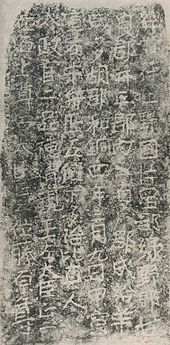Tago-hi
Tago-hi ( Japanese 多 胡 碑 , "Tago stone monument") is a three-part stone monument consisting of a foundation stone, a stele and a cap stone. The material is natural stone made of granite-like, so-called Ushibuse sandstone with a height of 1.29 m, a width of 69 cm and a thickness of 62 cm. The stone monument was erected in 711. On the front it shows a text of 80 characters, arranged in six vertical lines. The stone monument is located in Yoshii ( Takasaki ) in Gunma Prefecture , Japan . It belongs with the Yamanoue stone monument and the Kanaizawa stone monument to the “three stone monuments of Kōzuke” ( 上 野 三 碑 , Kōzuke sanpi ). The stone monument was declared a special historical site on March 20, 1954 .
overview

The pyramidal capstone of the monument is 25 cm high and, with a side length of 88 cm, towers over the engraved stele like a roof. The original foundation stone was also shaped like a pyramid with a square plan and engraved with the character kuni ( 國 ). Since the foundation stone was stabilized with concrete, the foundation stone and engraving are no longer visible today. The inscription on the stele between the base and capstone is engraved in the Reisho style . It says that by order of the Benkankyoku, a new local authority, the Tago-gun, was established. In particular, the meaning of the character 羊 is unclear and has led to a large number of theses. The attempts to explain move between the direction and the name. Since the two characters of the new regional authority Tago in themselves denote "much" and "uncivilized peoples, barbarians" and because there is the Koma Shrine ( 高麗 神社 ) built by Koreans nearby , the explanation is currently that it is a name, presumably that of a foreigner, favors.
The stone monument is now in a place called mikado ( 御 門 ). Excavations in 2016 unearthed the remains of a warehouse for a “gunga” ( 郡 einen ), an administrative seat of the provincial administrator, near the stone monument . This is why there are also considerations that the stone monument could only have been erected in the 2nd half of the 8th century. In any case, the trace of the stone monument is lost in the second half of the 9th century with the decline of the Ritsuryō system in the course of history until it was 700 years later in 1509 in the work Azumaji no tsuto ( 東路 の 津 登 ) by the Renga poet Sōchō reappears.
Another 200 years later, in the Edo period , it seems, based on the two scriptures Kōshinroku ( 盍 簪 録 ) and Yūken shōroku ( 輶 軒 小 録 ), in which a large number of people of cultural life are listed and those of Confucian Scholars Itō Tōgai derive that the stone monument was widely known. When Kumagaya Prefecture was reorganized and Gunma Prefecture was established in 1876, the official and politician Katori Motohiko recognized the importance and worthy of protection of the stone monument. After the monument was declared a special historical site in 1954, the municipal Tago Museum was also built in 1996, where the stone monument is now located behind a glass front.
Remarks
- ↑ Kōzuke is the old name of today's Gunma Prefecture.
- ↑ The Benkankyoku ( 弁 官 局 ) is an authority in the Japanese Ritsuryō system, which was originally set up on the Chinese model in the Asuka period . The authority itself was subordinate to the Daijō-kan, the State Council, which advised the Tennō.
- ↑ Today with the reading hitsuji , sheep
- ↑ Sino-Japanese Gomon, originally the name for the palace gates of the Tenno seat.
Individual evidence
- ↑ 多 胡 碑 . Cultural Affairs Office , accessed September 21, 2019 (Japanese).
- ↑ 多 胡 碑 . Takasaki City, accessed September 21, 2019 (Japanese).
Web links
Coordinates: 36 ° 15 '54 " N , 138 ° 59' 46.8" E

